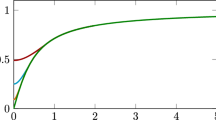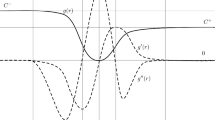Abstract
A new law has been proposed to describe the distribution of the cohesive forces present within the internally structured nonlinear zone that precedes the leading edge of a moving crack contained within a nonelastic solid. The nonlinear effects are modeled by the narrow strips emanating from the crack front and endowed with a certain internal structure (unlike the classic models of Barenblatt and Dugdale). The bulk of the material, though, is assumed to behave as linear elastic solid. Mathematical form the law resembles somewhat the Planck's formula used to explain radiation given off by a perfectly black body at very short wavelength of the visible light spectrum. With Sneddon's integral transformations employed and properly modified, the quantities essential in the Nonlinear Mechanics of Fracture have been quantified. In particular another so-called `ubiquitous eta factor' is discussed and related to the material microstructure by means of a certain transcendental equation. The eta-factor enters the formula for the specific work of fracture measured with specimens of various geometrical and loading configurations, and so far is known only empirically. Both the stationary and quasi-static crack problems are discussed. It has been shown that the variations in the microstructural parameters strongly affect the process zone along with the associated work of separation. The other important factors that influence the cohesive stress distribution and all the resulting fracture parameters, specifically those that are responsible for a ductile-to-brittle transition of fracture mode, are the characteristics of the state of stress induced in the vicinity of the crack front. These 3D effects are best represented by the triaxiality parameter, defined as the ratio of the mean stress to the von Mises effective stress
Similar content being viewed by others
References
Barenblatt, G.I. (1962). Mathematical theory of equilibrium cracks in brittle fracture. Advances in Applied Mechanics 7 55–79.
Broberg, K.B. (1999). Cracks and Fracture, Academic Press, New York.
Broberg, K.B. (1997). The cell model of materials. Computational Mechanics 19 447–452.
Broberg, K.B. (1977). On the treatment of the fracture problem at large scale yielding, Fracture Mechanics and Technology – Proceedings of an International Conference, held at Hong Kong, Vol. 2, (Edited by G.C. Sih and C.L. Chow), based on GALCIT Report, Caltech 1976, pp. 837–859.
Dugdale, D.S. (1960). Yielding of steel sheets containing slits. J. Mech. Physics Solids 8.
Faleskog, J. and Shih, C.F. (1997). Micromechanics of void coalescence. I. Synergistic effects of elasticity, plastic yielding and multi-size-scale voids. J. Mech. Phys. Solids 45 21–50.
Gao, H. and Klein, P. (1998). Numerical simulation of crack growth in an isotropic solid with randomized internal cohesive bonds. International Journal of Mech. Phys. Solids 46 187–218.
Goodier, J.N. and Field, F.A. (1963). Plastic energy dissipation in crack propagation. Fracture of Solids (Edited by D.C. Drucker), Wiley, New York.
Hunsacharooj, F. (1987). Resistance curves in Ramberg – Osgood strain hardening solids, unpublished Ph.D. Thesis, University of Wisconsin, Milwaukee.
Hutchinson, J.W. (1997). The role of plasticity in toughening of ductile metals and interfaces, seminar at Northwestern University in the series Colloquia on Modern Mechanics, March 1997, Evanston, IL.
Kolednik, O., Shan, G. and Fisher, F.D. (1997). The energy dissipation rate – A new tool to interpret geometry and size effects. Fatigue and Fracture Mechanics, ASTMSTP 1296, Vol. 27 (Edited by R.S. Piascik, J.C. Newman and N.E. Dowling), pp. 126–151.
Needleman, A. (1990). An analysis of decohesion along an imperfect interface. International Journal of Fracture, Vol. 42 21–40.
Rice, J.R., Drugan, W.J. and Sham, T.L. (1980). Elastic-plastic analysis of growing cracks, ASTM STP 700, ASTM, Philadelphia, pp. 189–221.
Rice, J.R. and Sorensen, E.P. (1978). Continuing crack-tip defeormation and fracture for plane-strain crack growth in elastic-plastic solids. J. Mech. Phys. Solids 26 263–286.
Siegmund, T. and Field, F.A. (1963). The role of cohesive strength and separation energy for modeling of ductile fracture, ASTM STP 1360, pp. 139–151.
Turner, C.E. (1996). Ubiquitous eta factor in ductile fracture. George R. Irwin Symposium, Indianapolis 1996, pp. 107–122.
Turner, C.E. (1990). A re-assessment of ductile tearing resistance, Part I: The geometry dependence of J-R curves in fully plastic bending; Part II: Energy dissipation rate and associate R-curves on normalized axes. Proceedings, Fracture Aehavior and Design of Materials and Structures, 8th European Conference on Fracture. (Edited by D. Firrao), EMAS, Warley, UK, pp. 933–949 and 951–968.
Tvergaard, V. (1997). Relations between crack growth resistance and fracture process parameters under large scale yielding. Nonlinear Analysis of Fracture (Edited by J.R. Willis), Kluwer Academic Publishers, Dordrecht, pp. 93–104.
Tvergaard, V. and Hutchinson, J.W. (1996). Effect of strain-dependent cohesive zone model on predictions of crack growth resistance. International Journal Solids and Structures 33 3297–3308.
Tvergaard, V. and Hutchinson, J.W. (1994). Effect of T-stress on mode I crack growth resistance in a ductile solid. International Journal of Solids and Structures 31 823–833.
Ungsuwarungsri, T. and Knauss, W.G. (1987a). The role of delayed-softened material behavior in the fracture of composites and adhesives. International Journal of Fracture 35 221–241.
Ungsuwarungsri, T. and Knauss, W.G. (1987b). A nonlinear analysis of equilibrium craze, Part I: Problem formulation and solution. Journal of Applied Mechanics 110 44–51.
Ungsuwarungsri, T. and Knauss, W.G. (1987c). Part II: Simulation of craze and crack growth. Journal of Applied Mechanics 52–58.
Wnuk, M.P., Omidvar, A. and Choroszynski, M. (1998). Relationship between the CTOD and the J-integral for stationary and growing cracks. Closed form solutions. International Journal of Fracture 87 331–343.
Wnuk, M.P. (1990). Mathematical Modeling of Nonlinear Phenomena in Fracture Mechanics (Edited by M.P. Wnuk), CISM Colloquia Series, Springer-Verlag, pp. 359–451.
Wnuk, M.P. (1989). Onset and early stages of fracture in inelastic solids, invited lecture delivered at the 21st Midwestern Conference on Mechanics, Michigan Technological University, Houghton, Proceedings of the 21 st Midwestern Conference on Mechanics, (Edited by J.A. Ligon, H.W. Lord, M. Vable, V.W. Snyder and G. Trevino), pp. 103–110.
Wnuk M.P. and Read, D. (1986). Essential work of fracture vs. energy dissipation rate in plane stress ductile fracture. International Journal of Fracture 31 161–171.
Wnuk, M.P. and Mura, T. (1983). Effect of microstructure on the upper and lower limit of material toughness in elastic-plastic fracture. J. Mech. of Materials 2 33–46.
Wnuk, M.P. and Mura, T. (1981). Comparative study of models for quasi-static tensile fracture. Special Volume on Recent Contributions to Mechanics of Solids, editor Eringen.
Wnuk, M.P. (1974). Quasi-static crack extension of a tensile crack contained in a visco-elastic-plastic solid. J.Appl. Mech. 41 234–242.
Xia, L., Shih, C.F. and Hutchinson, J.W. (1995). A computational approach to ductile crack growth under large scale yielding. J. Mech. Phys. Solids 42 21–40.
Yokobori, T. (1965). Strength, Fracture and Fatigue of Materials, Noordhoff, Groningen, The Netherlands.
Author information
Authors and Affiliations
Rights and permissions
About this article
Cite this article
Wnuk, M.P., Legat, J. Work of fracture and cohesive stress distribution resulting from triaxiality dependent cohesive zone model. International Journal of Fracture 114, 29–46 (2002). https://doi.org/10.1023/A:1014880921017
Issue Date:
DOI: https://doi.org/10.1023/A:1014880921017




